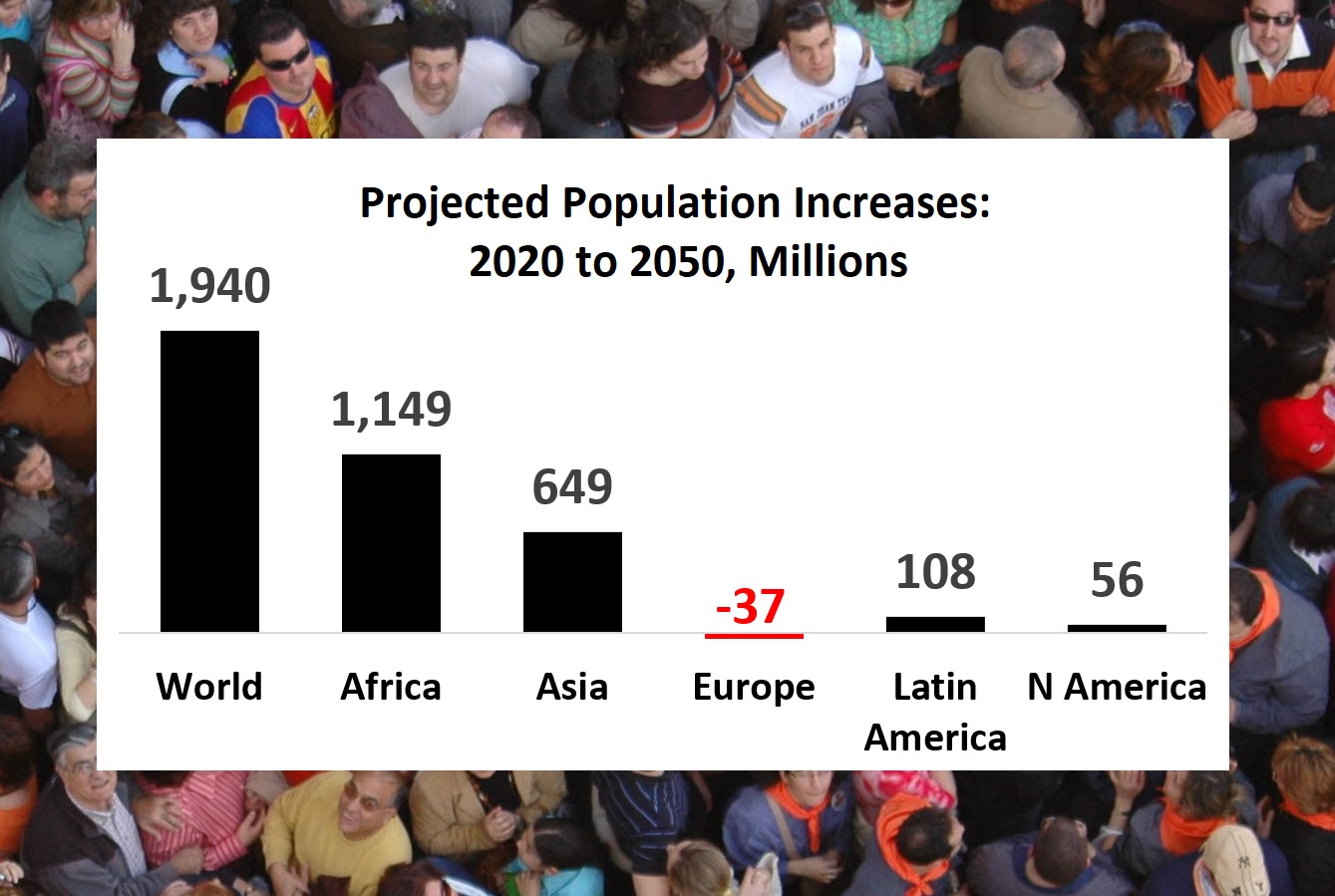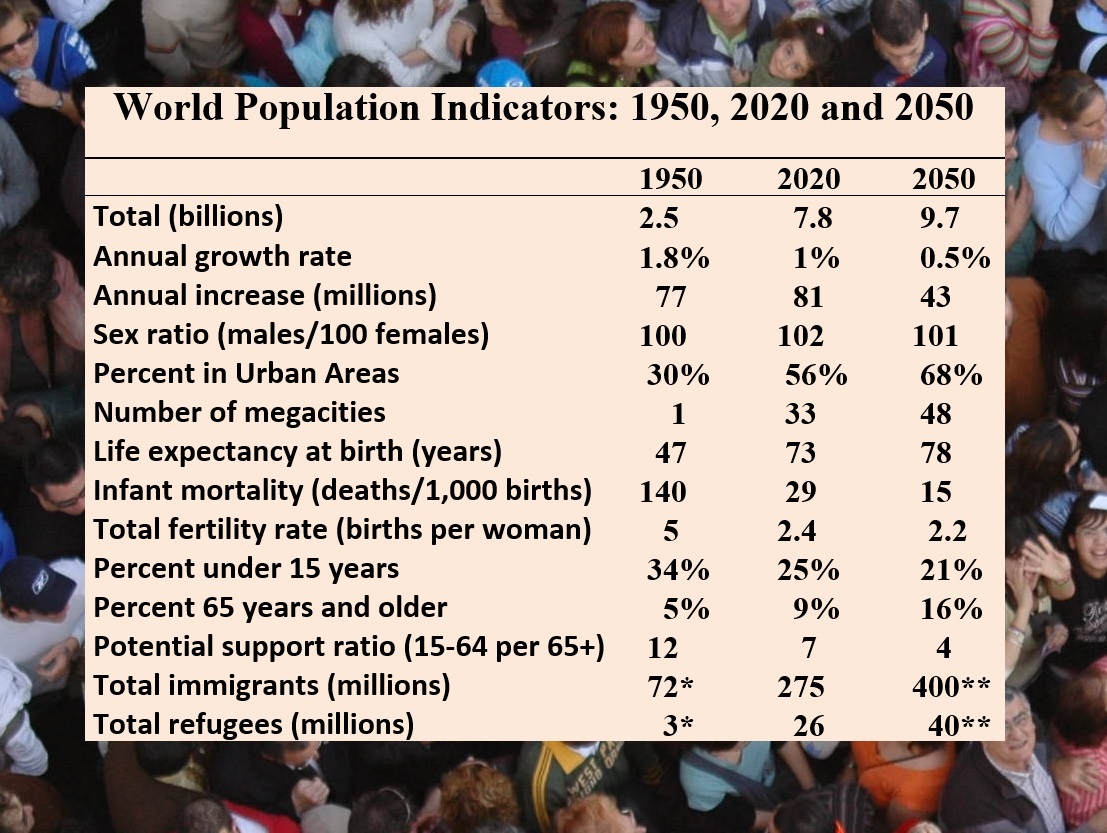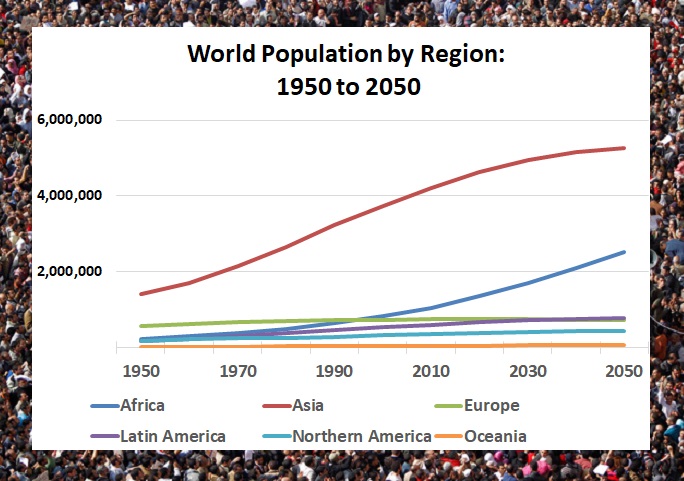Understanding global demographic trends is essential for government and business planners, offering insights into resolving numerous challenges. World population growth is slightly ahead of what was projected a few years ago, reports demographer Joseph Chamie. More than half the world lives in urban areas today, and that is expected to rise to 70 percent by 2050. Most population growth will continue in less developing nations while advanced economies experience population declines and greater proportions of elderly citizens due to increased life expectancy and reduced fertility rate. Chamie explains that more than 80 countries, half the world’s population, now post fertility rates below the replacement level. That leaves fewer workers available to support each individual over age 65, compelling governments and individuals to prepare for long retirements. Good planning can also prevent a variety of other hardships including food and water shortages, poverty, environmental degradation and even security crises. In 2011, former UN Secretary-General Ban Ki-moon pointed to the value of demographics and planning. “We cannot look at one strand in isolation,” he said. “Instead, we must examine how these strands are woven together.” – YaleGlobal
World Population: 2020 Overview
Governments and businesses can better manage resources by planning around population trends, including urbanization and aging
Joseph Chamie Tuesday, February 11, 2020

NEW YORK: Governments, businesses and investors find regular demographic reviews of the world population to be useful as considerable variations exist across regions – rich and poor, young and old, good health care or not, secure climates or not – that create enormous push-pull forces behind increased international migration flows. An understanding of world population levels, trends and projections constitutes an essential ingredient in strategic planning, policy development and program implementation for addressing global challenges and emerging issues.

The world population now stands at 7.8 billion inhabitants, having reached the 7 billion milestone in 2011. Demographers expect the 8 billion milestone in 2023, with global population projected to reach 9 billion by 2037 and 10 billion by 2056. This growth is slightly faster than projections from just a few years ago.
World population currently grows at 1 percent annually, having peaked at 2.1 percent in 1968. That annual growth rate is expected to continue declining, reaching 0.5 percent by midcentury. The current annual increase of world population is 81 million, lower than the peak level of 93 million in 1988. Annual additions are projected to continue declining, reaching 48 million by 2050. Of the nearly 2 billion increase in world population expected by midcentury, most will take place in less developed regions. Africa leads, expected to add more than 1 billion people over the coming three decades, followed by Asia with about 650 million. Europe’s population, in contrast, is projected to decrease by 37 million over this period.
Two countries have reached the billion mark: China and India, each with current populations of 1.4 billion, reached that milestone in 1980 and 1997, respectively. India’s current rate of demographic growth is double China’s, 1.0 versus 0.5 percent. India’s population could overtake China’s by 2027. No other country is expected to reach a billion during the 21st century. Nigeria, projected to grow to 733 million by century’s close, will move into third place by midcentury, overtaking the United States, anticipated to have 434 million people by 2100.
The population growth is extraordinary, with most occurring in the world’s poorer countries. More than 50 developing countries, most in Africa, post growth rates no less than 2 percent per annum. By midcentury about half of those countries are projected to see their populations more than double, including Angola, Burkina Faso, Democratic Republic of Congo, Mozambique, Niger, Nigeria, Tanzania and Uganda.
At the same time, some 20 countries, particularly more developed countries, navigate uncharted demographic territory of population decline and rapid aging. These include Greece, Hungary, Italy, Japan, Poland and Spain. This number could nearly triple by midcentury, and expected newcomers to population decline will soon include China, Germany, Russia and South Korea.

The world population’s sex composition has been relatively balanced and stable over the past 70 years, with a ratio of around 100 to 102 males for every 100 females. Notable exceptions to that general pattern are China and India, whose population sex ratios are above 105, largely due to sex-selective abortions of female fetuses. Sex ratios at birth of most countries are around 105 males per 100 females, yet the ratios have reached as high as 120 in China and 114 in India in recent years. Recent data suggest these ratios appear to be on the decline.
Throughout human history, most of the world’s population lived in rural areas. A decade ago, the situation flipped with urban dwellers becoming the majority of the world’s population. The proportion residing in urban areas has increased to 56 percent today and is expected to continue rising to nearly 70 percent by midcentury.
Coupled with world population’s urban shift is the marked increase in the number of megacities with populations of 10 million or more. While New York was the only megacity in 1950, the world has 33 megacities today, a number expected to rise to 43 within a decade. Some of the most rapid population growth of megacities in recent decades happened in Africa and Asia. Since 1990, the populations of no less than 10 megacities, including Delhi, Shanghai, Dhaka, Lahore and Lagos, have tripled in size
A welcomed demographic change is increased longevity. Over the past seven decades, life expectancy at birth for the world increased by 28 years, from 45 to 73, and reached highs in excess of 80 years in most developed countries with growing numbers of centenarians. Impressive declines in infant mortality since 1950 have led to the world’s infant mortality rate falling by 80 percent, from 140 to 29 deaths per 1,000 live births. These trends are expected to continue throughout the 21st century. The world population’s life expectancy at birth is projected to reach 77 years in 2050 and nearly 82 in by 2100.
Another welcome change: decline in fertility rates. With women and men gaining control over the desired number, spacing and timing of their children, global fertility has decreased significantly from an average of about five births per woman in 1950 to 2.5 births per woman today. The global fertility rate, now at 2.4 births per woman, is expected to reach the replacement level of approximately two births by 2050. The number of countries experiencing fertility rates below the replacement level, currently at a record high of 83 or about half of the world’s population, is expected to increase to 130 by midcentury, representing nearly two-thirds of world population.

As a result of low fertility and increased longevity, population aging has become a challenging issue in the 21st century. Before 1995, no country had experienced the historic reversal – with the elderly aged 65 years and older outnumbering children under age 15. Italy was the first in 1995, and now 34 developed countries live with this trend.
The historic reversal will continue in virtually every country, covering 90 countries by midcentury, and the world as a whole can expect the epochal transition in 2075.
A consequence of population aging is the decline in the ratio of the working age population to the elderly population. The world’s potential support ratio – or PSR, the total working-age population, aged 15 to 64 years, to those aged 65 years or older – has declined from 12 in 1950 to seven today. The decline in such support is continuing, expected to sink to four by midcentury. Among the more developed countries, PSR has fallen to comparatively low levels. The ratio for more developed regions has declined from about eight in 1950 to slightly more than three today. For some countries, such as Germany, Italy and Japan, the PSR has fallen below three and is expected to fall below two by 2050.
International migration has increased in recent years, with about 275 million people, or slightly more than 3 percent of the world’s population, residing outside the country of their birth. In addition, war, violence and persecution drove the forced displacement of people worldwide to another new high of 71 million at the end of 2018. Among them were 41 million internally displaced persons, 26 million refugees and 4 million asylum seekers.
Future international migration flows will continue, including the exodus of humanity’s desperate, taking place despite walls, barriers, guards, patrol ships and nativist political rhetoric. Governments of origin, transit and destination countries struggle with how best to cope with unauthorized migration flows.
Demographic trends, particularly population growth, decline, aging, urbanization and international migration, are contributing to the many challenges facing humanity, including food production, water shortages, poverty, housing, climate change, environmental degradation, human rights, civil unrest, displacement and armed conflict. Anticipating the consequences of those powerful demographic megatrends could stave off security and economic crises.
Joseph Chamie, a former director of the United Nations Population Division, is currently an independent consulting demographer.
The article appeared in the YaleGlobal newsletter on 11 February 2020
